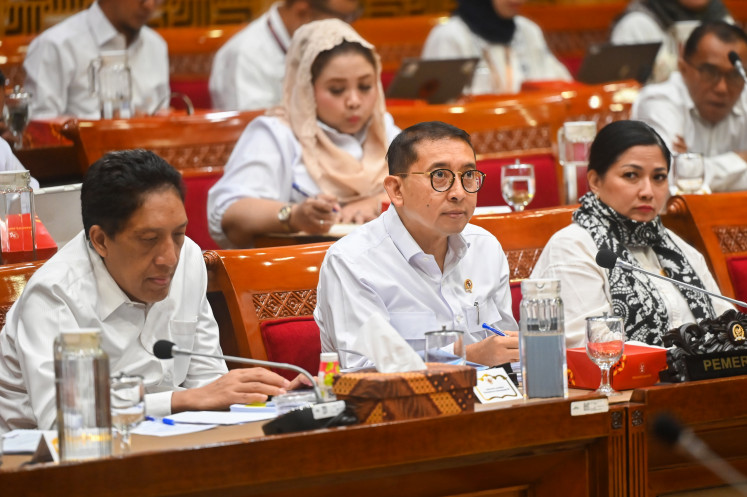Popular Reads
Top Results
Can't find what you're looking for?
View all search resultsPopular Reads
Top Results
Can't find what you're looking for?
View all search resultsLocal initiatives on stunting need government support
JP/DONYuli took her son Atu to the local health center in Pejeruk, Mataram, in West Nusa Tenggara, to measure his height against the colorful chart mounted on the wall
Change text size
Gift Premium Articles
to Anyone
JP/DON
Yuli took her son Atu to the local health center in Pejeruk, Mataram, in West Nusa Tenggara, to measure his height against the colorful chart mounted on the wall. But she blinked when Atu leaned back and his head touched the line that indicated the average height for a 9-month-old boy.
“How old is Atu?” the field officer asked, glancing back and forth from the crumpled measurements of the World Health Organization in her hand to the wall chart.
“Nineteen months old,” said Yuli.
Atu was three standard deviations below the median height for his age. According to the WHO Child Growth Standards, he was 7 centimeters shorter than his peers.
The WHO standards are used universally for evaluating child growth. The WHO refers to this growth curve as a reference for how children “should grow” in all countries, as it views that unconstrained growth of economically advantaged breastfed infants and children does not vary substantially.
Based on the WHO standard, the Indonesian 2013 Basic Health Survey (Riskesdas) estimates a 37.2 percent stunting prevalence and 12.1 percent wasting prevalence in children under the age of 5 years. However, only 2.5 percent of children present both wasting and stunting. The majority of the children were either short with normal weight (27.4 percent) or short and overweight (6.8 percent). This had led to skepticism regarding the association between poor nutrition and ill health, and growth of Indonesian children.
Leading Indonesian pediatricians argue that most of the “stunted” children are short for reasons other than nutritional or health. The WHO standards may not be an appropriate reference for assessing undernutrition in the Indonesian population. We should distinguish between children who are pathologically short and need medical intervention and healthy children who would not benefit from any intervention. This is to prevent the spending millions of dollars on unnecessary and erroneous interventions.
To prevent overestimating stunting prevalence and improper intervention, the Indonesian Pediatric Society’s Aman Bhakti Pulungan and his team have just released the New National Indonesian Growth Chart. The chart was developed by reanalyzing the 2013 Riskesdas and conducting a periodic survey to collect basic health data and indicators. Height and weight data on more than 300,000 children and adolescents in 33 provinces were used to generate the new chart.
The analysis indicates a marked mismatch between the WHO standards and Indonesian height and weight data. Indonesian children of both sexes are significantly shorter and mature slightly earlier than the WHO standards. This chart appears to be a breakthrough in determining the real prevalence of stunting in Indonesia.
However, more studies may be necessary, since more than 100 countries refer to the WHO chart and it is still debated among pediatric experts.
Nevertheless, President Joko “Jokowi” Widodo has included stunting on his priority agenda. To overcome stunting and malnutrition in children aged 6-59 months, the government has implemented a supplementary feeding program (PMT) in almost all regions of Indonesia and has allocated a special budget for the program since 2011.
As the name implies, the PMT provide these malnourished toddlers with only supplemental foods, such as mung beans, biscuits and milk. Not only are these insufficient, some parents have misused the program, in some cases reselling the boxes of biscuits and milk instead of feeding these to their own children. The parents then used the money to buy unhealthy foods such as fried snacks, candy and even cigarettes for the children’s fathers.
However, some local government initiatives reflect their commitment to reducing stunting and have yielded positive results. With a high stunting prevalence reaching almost 30 percent based on the above standards, the West Java administration has introduced several initiatives, including one called Ojek Makanan Balita (Omaba) in one of its regencies.
Omaba is a mobile food service for toddler health that uses ojek (motorcycle taxis) to distribute free healthy meals for underprivileged children under 5.
The meals are provided by an urban farming program in Bandung, while volunteers from the Family Welfare Movement distribute them using motorcycles provided by state-owned oil company Pertamina. Every day, underprivileged toddlers receive two healthy meals consisting of cakes, chicken nuggets, tempeh, steamed rice, vegetable noodles and cheese sticks.
Since Omaba was launched, the West Java administration claims that it has reduced the stunting rate in Bandung’s Gedebage district from 22 to 0 children. Meanwhile, the Administrative and Bureaucratic Reform Ministry recognized the program as the top 35 public service innovations of 2016.
East Nusa Tenggara (NTT) has also been paying special attention to stunting. With the highest stunting prevalence at around 40 percent, the local administration launched a PMT program called Gerobak Cinta (Wagon of Love) in July 2018. Stunted children under 2 years old are given additional meals, namely lunch, snacks, and dinner, for 90 consecutive days. Most of the ingredients used are local staples, such as sorghum, moringa, fish and eggs.
Puskesmas (community health centers) have also mobilized village midwives groups that enable their staff to distribute public health information every week. Such programs seem to have successfully reduced stunting in NTT. In August 2018, West Adonara in East Flores regency recorded that 516 of 1,233 children in the district were stunted. By June 2019, that figure had already declined to 318.
Obviously, the path to a stunting-free region does not smoothen overnight. One of the main hurdles is funding.
In regions with a high stunting prevalence, the current health budget allocation from the central government is insufficient to support local initiatives, even while government regulations oblige villages to boost their health budget.
It is good to hear that President Jokowi noted in his recent state of the nation, delivered at the House of Representatives, that the health budget will be increased from Rp 123.1 trillion (US$8.9 billion) this year to Rp 132.2 trillion in 2020. The government also plans to expand its intervention to reduce stunting in 260 districts in 2020.
Omaba and Gerobak Cinta are two good local initiatives that can be implemented in other regions. As the central government has outlined an ambitious target to lower the country’s stunting prevalence from 30.8 percent in 2018 to 19 percent by 2024, it is hoped that more good local initiatives will be supported in the near future — along with a better, localized standard for measuring stunting.
_____________________
Master of Public Health student at Harvard University, currently researching stunting in developing countries.










